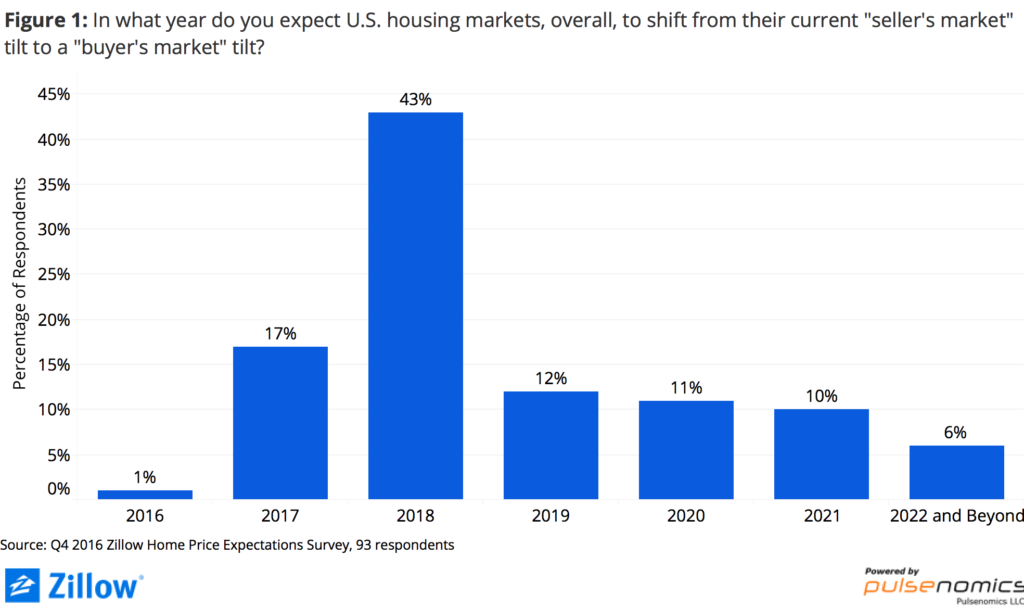October 2016 Market Report: Change is Coming. Really.


Stop us if you’ve heard this before: Low and falling inventory of available homes for sale, coupled with strong and growing demand from would-be home buyers, is helping drive up home values and creating intense competition in the housing market that’s leaving home sellers in control.
If you’ve been paying even passing attention to the housing market in recent months, then of course you’ve heard that before. Those larger trends have been driving the U.S. housing market for months, if not years, and they were little changed last month. Overall U.S. inventory of homes for sale fell 5.7 percent year-over-year in October, the 21st consecutive month of annual inventory declines, according to the October Zillow Real Estate Market Reports. Median U.S. home values rose 6.2 percent from October 2015, to a Zillow Home Value Index (ZHVI) of $191,200, the 51st straight month of annual home value gains.
But change will eventually come, and perhaps sooner than you think. No, really.
 A large majority (72 percent) of experts surveyed in the most recent Zillow Home Price Expectations Survey[1] said the pendulum was likely to swing back into buyers’ favor in 2017, 2018 or 2019. Of those expressing an opinion, 17 percent said the balance of power would shift to buyers in 2017, 43 percent said the shift would occur in 2018 and 12 percent said it would happen in 2019 (figure 1).
A large majority (72 percent) of experts surveyed in the most recent Zillow Home Price Expectations Survey[1] said the pendulum was likely to swing back into buyers’ favor in 2017, 2018 or 2019. Of those expressing an opinion, 17 percent said the balance of power would shift to buyers in 2017, 43 percent said the shift would occur in 2018 and 12 percent said it would happen in 2019 (figure 1).
A meaningful shift in balance between home buyers and sellers boils down to a few things sorely lacking for buyers in the current market: choice, and time. Because there are so few homes on the market, and because there are so many buyers chasing those homes, buyers must often make quick offers on available homes, or be exceedingly patient waiting for the ideal home to hit the market, then pouncing aggressively once it does.
Sellers, on the other hand, can get away with a bit more. The prevalence of fixer-upper homes listed for sale is on the rise, and in many places they’re fetching prices fairly close to better-kept homes. Even those sellers looking to sell the most well-cared-for homes often have the luxury of listing it as-is with only minimal window-dressing since demand for homes has been high and inventory low. Additionally, it’s common for sellers to receive multiple bids, and in the hottest markets, sell for over asking price. This, in turn, prices out many would-be buyers and forces them back to the drawing board: Less than half of buyers are successful in purchasing the first home they make an offer on, according to the Zillow Group Consumer Housing Trends Report
But these conditions will change in the future. The number of homes for sale will rise as builders ramp up and more sellers look to capitalize on recent home value gains. This will also help to cool off rapid home value appreciation, making it easier for would-be buyers to save for a down payment and not feel so much like they’re trying to hit a moving target. As this happens, the market’s balance should meaningfully swing in favor of buyers.
But for now, sellers remain very much in the driver’s seat. And it’s a rough ride for buyers.
Portland, Dallas and Seattle reported the highest year-over-year home value appreciation among the 35 largest metros across the country for the third month in a row. Home values in Portland rose almost 15 percent to a median home value of $349,500. Dallas and Seattle home values have appreciated just over 12 percent since last October.
Rents across the nation are up 1.4 percent, to a median rent payment of $1,402 per month. Seattle, Portland and Sacramento reported the highest year-over-year rent appreciation among the 35 largest U.S. housing markets. Rents in Seattle are up 9 percent to a Zillow Rent Index[2] (ZRI) of $2,087. Rents in Portland and Sacramento are up 7 and 6 percent, respectively.
There are 6 percent fewer homes for sale across the country than a year ago, with Boston, Indianapolis and Kansas City reporting the greatest drop in inventory among the 35 largest U.S. metros. In Boston there are 26 percent fewer homes to choose from than a year ago, and 24 percent fewer in Indianapolis.
Use the interactive tool below to explore local home value, rent and inventory dynamics in your market, both over time and by market segment.
[1] The latest edition of the Zillow® Home Price Expectations Survey surveyed 111 experts between October 28 and November 15, 2016. The quarterly survey is conducted by Pulsenomics LLC on behalf of Zillow, Inc. and asks experts about their expectations for the housing market and their opinions on issues relevant to housing.
[2] The Zillow Rent Index (ZRI) is the median Rent Zestimate® (estimated monthly rental price) for a given geographic area on a given day, and includes the value of all single-family residences, condominiums, cooperatives and apartments in Zillow’s database, regardless of whether they are currently listed for rent. It is expressed in dollars.